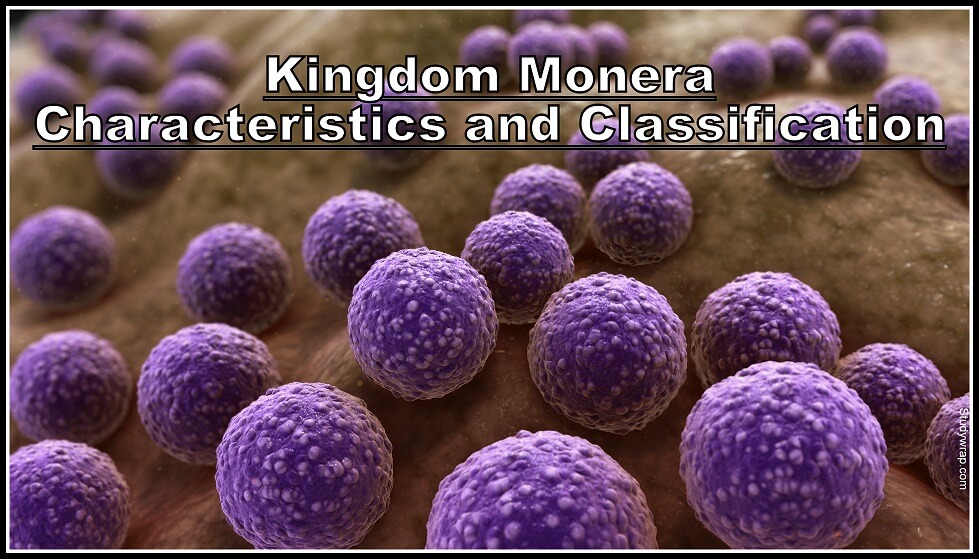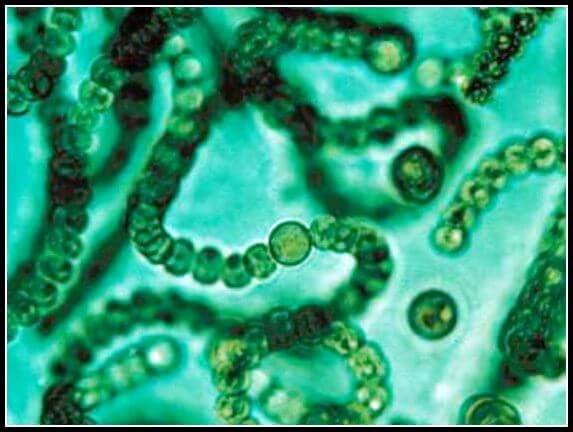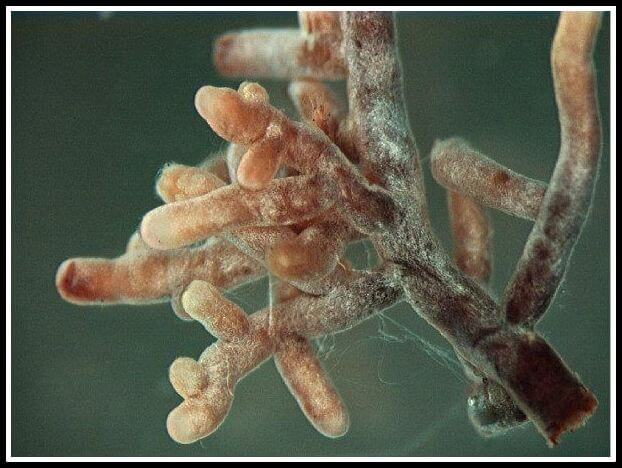Kingdom Monera – Characteristics and Classification
Kingdom Monera
Table of Contents
· The word Monera is derived from Greek word ‘moneres’ which means ‘single’.
· Monera, also known as Prokaryota, is a biological kingdom that is made up of prokaryotes. It is the first Kingdom in the Five Kingdom Classification System.
· It includes the most primitive forms of life which developed from an early stock known as progenote.
· It is composed of single-celled organisms that lack a true nucleus. Being the earliest forms of life, Monerans are adapted to all types of habitats.

Important Characteristics of Kingdom Monera
· Monerans are mainly unicellular and are the most primitive of living forms.
· They are diverse in their nutrition i.e. saprotrophic, parasitic, chemoautotrophic, photoautotrophic and symbiotic. The photoautotrophs include both aerobes and anaerobes.
· The cells are microscopic (0.1 to a few microns in length).
· Most organisms bear a rigid cell wall which contains peptidoglycan and polysaccharides other than cellulose.
· Cells have one envelope type of organisation, i.e., the whole protoplast is covered by plasma membrane but internal compartmentalisation is absent.
· All membrane bound cell organelles are absent, e.g., mitochondria, lysosomes, Golgi bodies, plastids, etc.
· Nucleus is absent. The genetic material is naked circular DNA, not enclosed by nuclear envelope. DNA lies coiled inside the cytoplasm and is known as nucleoid.
· Plasmids may be present in the bacterial cell which can duplicate independent of the genomic DNA. Plasmids often code for particular enzymes or for antibiotic resistance.
· The flagella, if present, are single stranded. They are formed of protein called flagellin.
· Some bacteria also contain very fine, short appendages on the cell surface which are called pili. They help bacteria in sexual reproduction and in attaching to host.
· Reproduction is primarily asexual by binary fission or budding.
· Gametes are absent. Gene recombination has been discovered in certain cases.
Classification of Kingdom Monera
· There are two major groups of Monerans in Kingdom Monera –
· Archaebacteria – include ancient and primitive forms of bacteria of Kingdom Monera. Based on the occurrence they can be, Methanogens, Halophiles and Thermoacidophiles.
· Eubacteria – include true bacteria. They are of two types, bacteria and cyanobacteria. Rickettsiae, Actinomycetes, mycoplasmas, etc., are various groups included in eubacteria.
Archaebacteria
· Archaebacteria are considered to be the ‘Oldest of Living Fossils’.
· These are simplest and most primitive group of bacteria.
· The cell wall of these bacteria is made of polysaccharides and proteins (peptidoglycans and muramic acid are absent in cell wall). This rigid cell wall supports the cell, allowing an archaebacteria to maintain its shape.
· Further branched chain lipids are present in plasma membrane of archaebacteria, due to which these can face extremes of conditions of temperature and pH.
· Most of the archaebacteria are autotrophs. They use pigment bacteriorhodopsin for photosynthesis.
· The archaebacteria are non-pathogenic bacteria that live in and around other organisms.
· They may be Spherical, Rod Shaped, Spiral or Irregular in Shape.
Types of Archaebacteria
· Three main types of archaebacteria are –
1. Methanogens –
· These are strict anaerobic bacteria and mainly occur in muddy areas and also in intestinal tract of bovine animals such as Cow where cellulose is fermented by microbes.
· These are responsible for methane gas (CH4) formation in biogas plants, because they have capacity to produce CH4 from CO2.
· Eg. Methanobacterium, Methanococcus.
2. Halophiles –
· These bacteria occur in extreme saline or salty conditions.
· A pigmented membrane containing bacteriorhodopsin is developed in these bacteria, which utilises light energy for metabolic activities.
· Eg. Halobacterium, Halococcus.
3. Thermoacidophiles –
· Organisms that can survive in extremely high temperatures and low pH. They are found in hot sulphur springs (upto 80°C).
· These are aerobic bacteria, which have the capacity to oxidise sulphur to H2SO4 at high temperature and high acidity, hence given the name Thermoacidophiles.
· Eg. Thermoplasma, Thermoproteus.
Eubacteria
· There are thousands of different eubacteria or ‘true bacteria’.
· The Eubacteria are cosmopolitan, they live everywhere, soils, water, faeces, decaying substances, bodies of plants and animals.
· They are characterized by the presence of a rigid cell wall made up of Peptidoglycan (Murein).
· Their cell membrane contains lipids made up of glycerol ester lipids.
· If eubacteria are motile (e.g. E. coli), a flagellum is present which is made up of protein flagellin.
· Depending on the nature of the cell wall and the stain which they take up during Gram’s staining, they can be grouped into two categories –
o Gram-positive bacteria
o Gram-negative bacteria
Types of Eubacteria
· Given that all bacteria (except archaebacteria) of Kingdom Monera fall under the domain/subkingdom eubacteria, they may be grouped into the following categories:
· Photosynthetic Autotrophs
· Chemosynthetic Autotrophs
· Heterotrophic Bacteria – Heterotrophic bacteria may be divided into the following groups –
o Chlamydias (parasitic bacteria)
o Cyanobacteria (Blue-green algae),
o Gram-positive bacteria,
o Proteobacteria or Gram-negative bacteria
o Spirochetes etc.
Cyanobacteria
· Cyanobacteria are the only Monerans Gram negative photosynthetic bacteria that have the ability of oxygenic photosynthesis. They are also called as BGA (Blue green algae) and are classified as cyanophyceae or myxophyceae.

Characteristics
· Cyanobacteria vary greatly in their shape and appearance.
· These are unicellular or multicellular forms in filamentous or colonial type. Filamentous form consists of one or more cellular strands that is called as trichomes. Cyanobacteria lack flagella.
· The cell wall has 4 layers with the cover mucilaginous sheath made from the mucopeptides.
· The cell does not have a well-defined nucleus instead have centrally located chromatin material similar to that of the bacterial chromosome.
· The cyanobacterial cell produces distinct reserve food material in the forms of granules that store biomolecules.
· The protoplast is prokaryotic and thus does not have membrane-bound organelles like endoplasmic reticulum, Golgi bodies, mitochondria, lysosomes, plastids and contains 70S ribosomes.
· Their photosynthetic system closely resembles to eukaryotes because they have chlorophyll a. They also have phycobiliproteins (i.e. Phycocyanin, phycoerythrin etc.) as accessory pigments.
· Cyanobacteria mostly multiply by asexual methods. It include binary fission, budding, fragmentation etc. Fragmentation of filamentous cyanobacteria can generate small, motile filaments called hormogonia.
· Many filamentous or trichome-forming cyanobacteria fix atmospheric nitrogen by means of special thick-walled cells called heterocysts.
· There are five orders of cyanobacteria – Chroococcales (Chamaesiphon, Gleocapsa, Synechococcus); Pleurocapsales (Pleurocapsa, Dermocarpa); Oscillatoriales (Lyngbya, Spirulina, Oscillatoria); Nostocales (Anabaena, Nostoc, Cylindrospermum, Scytonema); Stigonematales (Stigonema, Fischerella).
· Cyanobacteria are highly tolerant of environmental extremes and are present in almost all aquatic and terrestrial environments.
· Oscillatoria, a cyanobacterium is highly pollution resistant and grows in fresh water with high organic matter, acts as indicator of water pollution.
· Nostoc is a colonial cyanobacterium that is popularly called moonspit, fallen star or star jelly.
· The cyanobacterium Spirulina is cultivated for human consumption and has a dry weight protein content of about 70%. This is sold as a nutritional food supplement.
Chlamydia
· They are gram-negative, non-motile and multiply in the cytoplasm of the host cell.
Characteristics
· The chlamydial cell is roughly spherical and measures between 0.3 and 1.0 µm in diameter.
· They contain cell walls which are similar to the cell walls of gram-negative bacteria.
· Under the cell wall lies a separate cytoplasmic membrane made up of large amounts of lipid.
· The DNA occurs as an irregular mass in the cytoplasm.
· Ribosomes can be seen throughout the cytoplasm.
· The cells contain no capsule or flagella.
· Intracellular parasitism is due to a lack of ATP-generating ability and the need to obtain ATP from the host cell. The cells can synthesize DNA, RNA and protein.
· They multiply by Binary Fission and multiply in the cytoplasm of the host cell.
Rickettsia
· Rickettsia are Gram negative obligate pleomorphic but intracellular parasites which are resident or are transmissible by arthropods i.e. Lice, Fleas, mites and ticks etc.
· They are intermediate between true bacteria and viruses.
Characteristics
· They have size 0.3-0.5 µm which is smaller than true bacteria but have a long generation time.
· Rickettsia require exogenous factors for growth.
· Cell wall is like typical bacterial wall. ATP synthesis is absent, but ADP is exchanged with host cell ATP.
· Flagella, pili and capsule are absent.
· Reproduction occurs by binary fission.
· The natural habitat of rickettsiae is in the cells of arthropod gut.
· They often become pathogenic in mammals and humans where they cause typhus group of fever spread by droplet method, lice, ticks, fleas, etc., e.g., Coxiella burnetti (Q fever), Rickettsia rickettsiae (Rocky mountain spotted fever spread by ticks), R. typhi (Endemic typhus), R. prowazeckii (epidemic typhus), Rochalimaea quintana (Trench fever).
Actinomycetes
· Actinomycetes belong to the group of prokaryotic, gram-positive bacteria which are having a filamentous structure due to which it also refers as “Thread or Ray bacteria”.
· They are intermediate between Bacteria and Fungi.
· Actinomycetes digest the complex carbohydrates like chitin, cellulose, hemicellulose etc. It also helps in the degradation of toxic compounds from an environment. Thus, it plays an essential role in the bioremediation of organic compounds.

Characteristics
· Actinomycetes are mycelial bacteria which form radiating colonies which are most abundant in Soil and marine Habitat.
· Mycelial form is reduced in Mycobacterium and Corynebacterium. The size of Actinomycetes is 1-2 µm in diameter.
· Cell Wall contains mycolic acid (fatty acid), lipid and wax.
· These are usually rod shaped with a filamentous and branched structure. The filaments contain mumaric acid.
· Most of the species are aerobic, but few are anaerobic to facultative aerobes.
· Different modes of reproduction occur by conidia, sporangiospores and arthrospores or oidia and fragmentation.
· Most of the actinomycetes are saprotrophic and constitute an important component of decomposers, e.g., Actinomyces, Streptomyces. A few are pathogenic in plants, animals and humans, e.g., Mycobacterium.
· A number of antibiotics are produced by actinomycetes, especially the genus Streptomyces (streptomycin, chloramphenicol, tetracyclines, terramycin, erythromycin, viomycin, novobiocin, nystatin).
Mycoplasma
· Mycoplasmas are the “smallest, independently replicating prokaryotes” first discovered by Pasteur in 18th century when he studied the causative agent of the “Bovine pleuropneumonia”.
· It was first isolated and cultured by E. Nocard and E. R. Roux in 1898 in the pleural fluid of cattle’s suffering from pleuropneumonia and therefore, called pleuropneumonia like organisms (PPLO).
· BorreI et al (1910) gave them the name Asterococcus mycoides. Later, Nowak (1929) placed them in the genus Mycoplasma.
Characteristics
· They are unicellular, smallest, non-motile and prokaryotic organisms and are pleomorphic i.e. can change their shape and thus are called jokers of microbiology.
· They do not possess rigid cell wall due to which they can change their shape easily.
· The structure of mycoplasma varies from species to species, they may be rod like, ring like, globoid or filamentous.
· They have 3-layered cell membrane, made of lipoproteins.
· Within the cytoplasm fine fibrillar DNA is present. It is double stranded helix.
· Mycoplasmas are parasitic as well as saprophytic. Mycoplasma are now known to infect a large number of animals and plants.
· In nature they occur in soil, sewage water and in plant and animal bodies. Besides, they have also been found in hot water springs. In the laboratory, they are common contaminants of cultures rich in organic matter.
· They usually reproduce by binary fission, Budding or Fragmentation.
Difference between Archaebacteria and Eubacteria
|
|
Archaea |
Eubacteria |
|
Meaning |
Archaea are single-cell, simple microorganisms and are capable of surviving under extreme condition. They are considered as the most primitive cells. |
These are also single-cell but have the complex structure. All types of bacteria except archaea falls under this category. |
|
Habitat |
Archaea are found in unusual environment like in hot spring, ocean depth, and salt brine etc. |
Eubacteria are found almost everywhere. It is found in all living and non-living organisms, soil, water etc. |
|
Cell Wall |
The cell wall is pseudopeptidoglycan. |
The cell wall is made up of peptidoglycan with muramic acid or sometimes with lipopolysaccharide. |
|
Types |
Methanogens, Halophiles, Thermoacidophiles. |
Gram-positive and gram-negative. |
|
Reproduction |
Archaea reproduce asexually by binary fission, fragmentation, or by the budding process. |
Bacteria can produce spores which allow them to live in unfavourable condition. |
|
Impact factor |
Archaea are non-pathogens, meaning they are not harmful. |
Eubacteria are pathogens, meaning they may cause diseases in humans. |
|
Examples |
Pyrolobus fumarii, Pyrococcus, Methanobacterium |
Streptococcus pneumonia, Escherichia coli (E.coli), Salmonella enterica. |
So, this was all about the Kingdom Monera – Its characteristics and Classification and Types of Archaebacteria and Eubacteria. In the Next Post (Click Here) we will discuss about the Structure of Bacteria in detail.
If you liked our post than do share it with your friends and family and also subscribe to our Facebook page to get regular updates.

